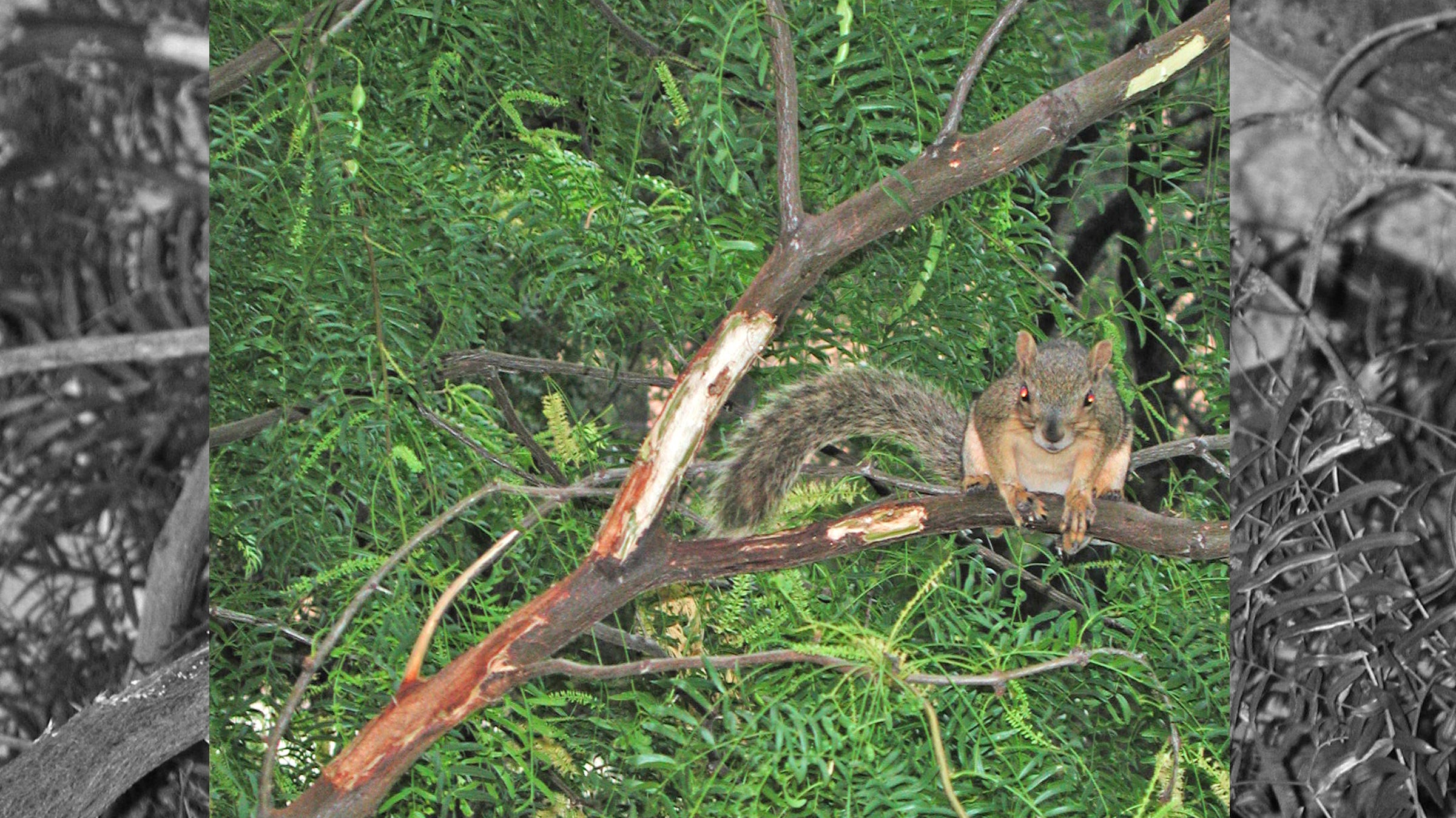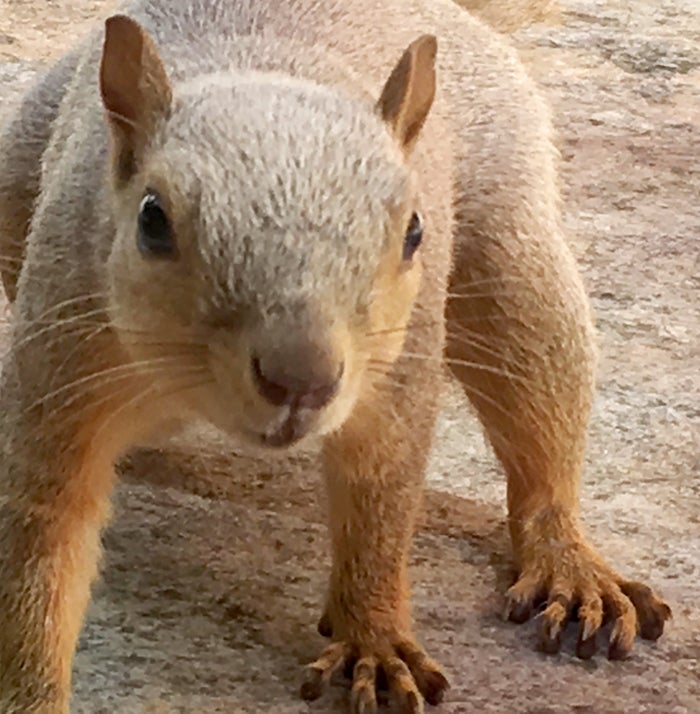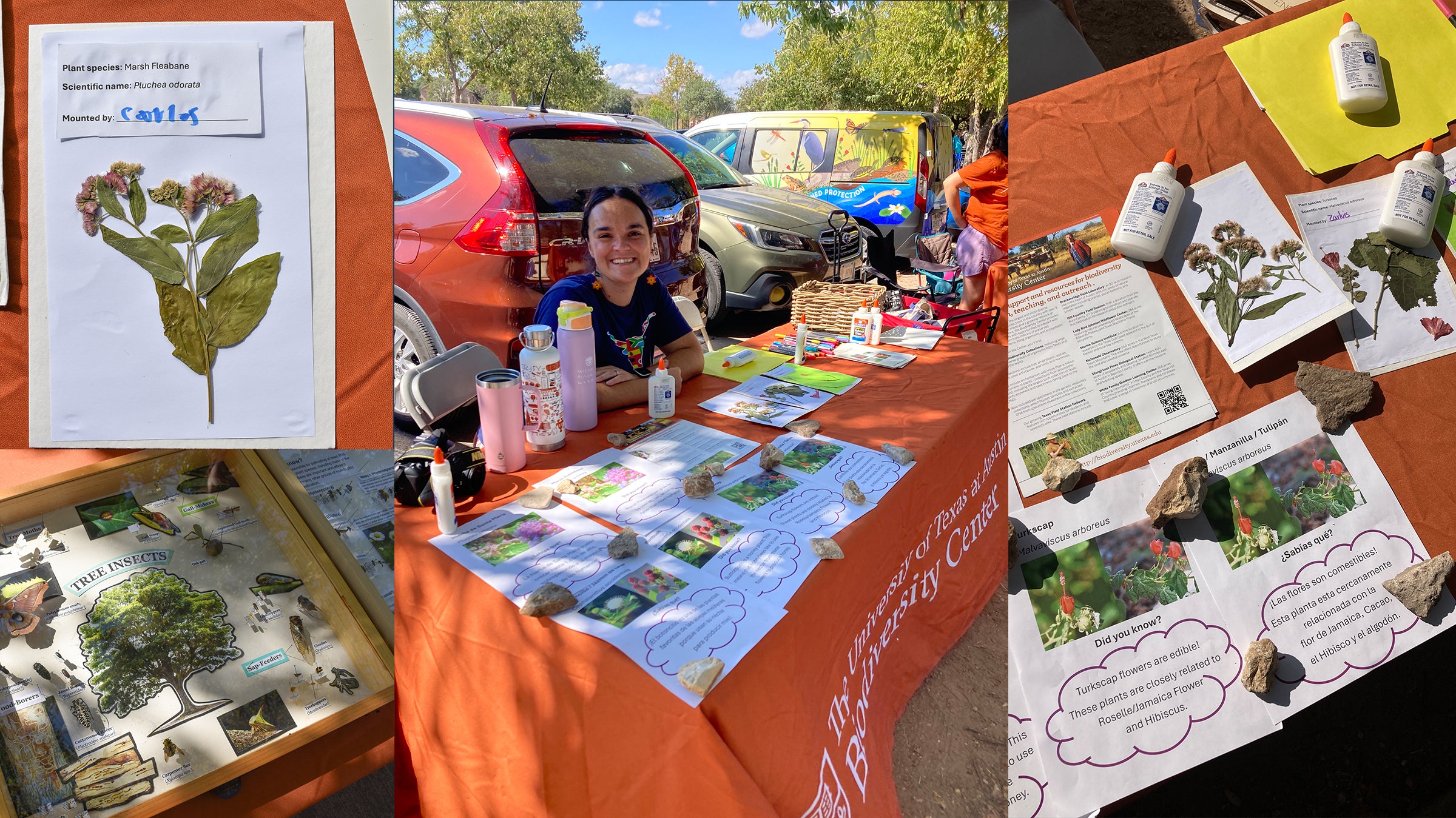
Fox squirrel vs. mesquite: this one is girdling a mesquite for lunch. (Photo: Dr. Larry Gilbert)
The fox squirrel (Sciurus niger) has made quite a comfortable existence for itself on the UT Austin campus. In trees, bushes, trashcans, or coming to beg for a bite of your lunch, it’s hard to miss these furry little mammals.
Commonly known as the eastern fox squirrel or Bryant’s fox squirrel, fox squirrels are members of the family Sciuridae, a family that includes small or medium-size rodents. In North America, fossils record the evolutionary history of tree squirrels back to the Late Eocene Epoch 41.3 million to 33.7 million years ago. Fox squirrels are the largest species of tree squirrels that are native to North America.
Fox squirrels are excellent climbers and jumpers, with their jumps sometimes spanning fifteen feet in a horizontal leap, and their free-falls can measure twenty or more feet but cause no harm to the animal. Fox squirrels also have sharp claws and can descend a tree head-first. They do this by rotating their ankles 180 degrees. This enables the hind paws to point backwards and grip the tree bark from the opposite direction.
The tail, probably the most notable feature of a squirrel, assists with balance and keeps the animal warm. The squirrel also communicates with its tail. The flicking they do is a sign of the creature being upset or nervous.
Squirrels also have excellent vision and sensitive touch due to vibrissae, which are modified hairs on their heads and limbs. Vibrissae are different from ordinary squirrel hair as they are longer, thicker, and specialized for sensing. On fox squirrels, vibrissae are above and below the animal’s eyes, on their noses, chins, and forearms.
The diet of fox squirrels is varied and dependent on their geography. On campus, fox squirrels eat insects, tubers, roots, tree saplings, and “mast,” the fruit of trees like live oaks. The acorns in their diets are rich in tannins, which are poisonous to many other mammals, but keep squirrels free of tapeworm and roundworm. Squirrels also don’t hesitate to take food handouts from UT’s community. However, this has caused a problematic squirrel explosion on campus, so feeding squirrels is not encouraged.

A curious and fearless blond fox squirrel. (Photo: Kristin Phillips)
Fox squirrels can be seen around campus burying nuts to store for winter food. They will later relocate them using their sense of smell. These little guys stay busy, as they can bury several thousand nuts over the course of a few months. Squirrels only find a portion of these buried nuts, which assists in propagating and spreading many species of nut trees. However positive this might be for aspiring saplings, squirrels also do severe damage to trees and saplings when they eat the bark. This action will “girdle” a tree. If squirrels eat the entire cannibal layer, the branch distal to the girdling dies. Mesquites are a favorite of squirrels on campus, and could explain why there is a lack of coexistence of oaks and mesquite on campus.
Favored amongst the UT squirrel population are the “albino” squirrels, which are sometimes seen outside the PAT and POB buildings. These squirrels are actually not albinos, but blond fox squirrels. They are leucitic, leucism being a condition in which there is a partial loss of pigmentation in an animal, causing white or pale coloration of skin, scales, feathers, or hair, but not in the eyes. This is often confused with albinism, which results in the reduction of melanin production only, through the melanocyte (or melanophore) is still present. A bit of fun campus lore circulates around blond fox squirrels: if a student catches sight of one before an exam, the student will get an “A.”
The Campus Biodiversity series explores the urban wildlife and plant life of UT Austin.
SOURCES:
Calahan, Rose. “Forty Acres Field Guide: Fox Squirrel.” Alcalde. (June 25, 2013)
“Eastern Fox Squirrel (Sciuris niger)” Texas Parks and Wildlife,
(accessed online: https://tpwd.texas.gov/huntwild/wild/species/easternfoxsquirrel/)
Gilbert, Lawrence. Dr. (email correspondence)
“Introducing Mammals to Young Naturalists: Squirrels.” Texas Parks and Wildlife (accessed online: https://tpwd.texas.gov/publications/nonpwdpubs/introducing_mammals/squirrels/)
Jackson, Chris. “Fox squirrel oddities,” DFW Urban Wildlife, March 10, 2015. (access online http://dfwurbanwildlife.com/2015/03/17/chris-jacksons-dfw-urban-wildlife/fox-squirrel-oddities/)
Thorington, Richard W.; Koprowski, John L.; Steele, Michael A.; Whatton, James F. (2012). Squirrels of the World. Johns Hopkins University Press. p. 8.
“Sciurus niger: Eastern Fox Squirrel.” Smithsonian National Museum of Natural History. (accessed online: https://naturalhistory.si.edu/mna/image_info.cfm?species_id=299)
Weber, Jim and Lynne. “Meet Central Texas’ Squirrels” Austin 360. February 13, 2012. (accessed online:



